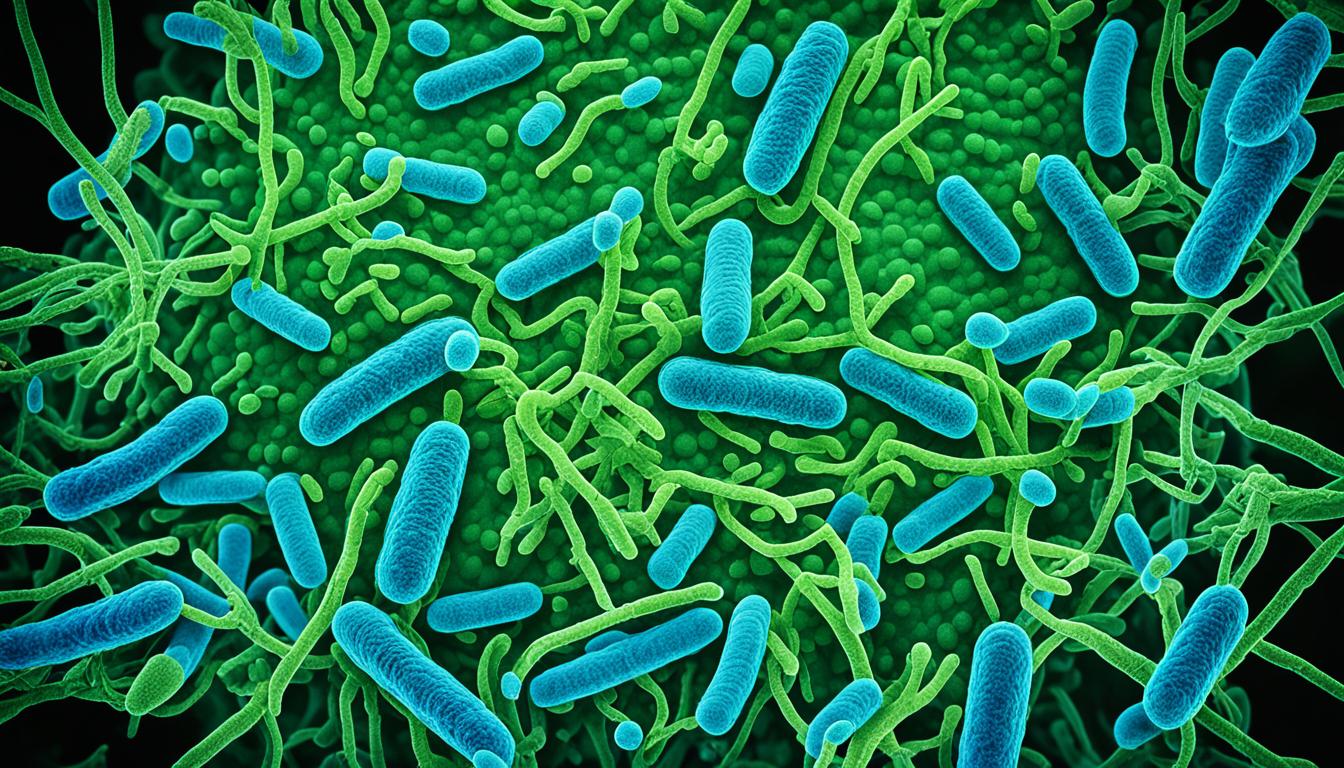Salmonella infection is a widespread foodborne illness. Millions worldwide get sick from it every year. It’s caused by the Salmonella bacteria. This illness brings on symptoms like diarrhea, stomach cramps, and fever. In serious cases, it might require hospital care or prove fatal. The main way it spreads is through eating contaminated food. This includes raw or not fully cooked poultry, eggs, and dairy that hasn’t been pasteurized. To avoid this, it’s important to keep your hands clean and handle food properly.
In Thailand, many people face the threat of Salmonella. The country has had its fair share of infections in the past few years. So, keeping the public safe is a top priority.
Key Takeaways:
- Salmonella infection is a foodborne illness caused by the Salmonella bacteria.
- Symptoms of Salmonella infection include diarrhea, abdominal cramps, and fever.
- Contaminated food, especially raw or undercooked poultry, eggs, and unpasteurized dairy products, is the main source of transmission.
- Practicing good hygiene and safe food handling is crucial in preventing the spread of Salmonella.
- Thailand has witnessed several outbreaks of Salmonella infection, making it an important health concern in the country.
Causes and Pathogenesis of Salmonella Infection
Salmonella infection comes from eating or drinking something with these bacteria. They live in many places and contaminate foods like chicken, eggs, and dairy. If someone eats or drinks the bacteria, they can get sick. Salmonella can spread when many people eat or drink the same bad food or water.
When you get infected, the bacteria attack the lining of your gut. They make toxins and irritate the gut, causing a sickness. This leads to diarrhea, stomach pain, and fever.
Quickly finding and treating Salmonella is key to avoid getting really sick. Doctors might give antibiotics in bad cases to help. But, these drugs might not kill all the bacteria. So, staying hydrated is also important for recovery.
Some might face more serious problems from Salmonella, like infections in their blood or other places. Children, the elderly, and those with weak immune systems are more at risk. Seeing a doctor early can stop these issues and help you get better faster.
To stay safe, wash your hands often, especially before and after preparing food or after using the bathroom. Cook your food well and keep it at the right temperatures to kill bacteria.
Stem Cell Therapy for Salmonella Infection
Stem cell therapy is a new way to fight infectious diseases like Salmonella. It uses cells that can turn into different types, helping with healing and fighting off germs. This means it might help with making the body better at fixing itself and attacking the bacteria.
For Salmonella specifically, using stem cell therapy looks hopeful. It seems to boost the body’s defense against the bacteria and helps tissues heal faster. Early signs are positive, indicating it could make recovering from Salmonella easier with fewer risks.
But, we still need more studies to be sure. Scientists are figuring out the best ways to use stem cell therapy. They want to know the right cells to use, how much to give, and the best way to give them. This is so it works as best as it can.
Before being widely used, we have to make sure stem cell therapy is safe and works well for Salmonella. Even though it seems promising at first, it needs to go through big tests and get approved. This is important to protect the people who might use it from any harm.
By learning more and working on this treatment, we might find a better way to deal with Salmonella. This new method could lead to less sickness and make getting better faster and easier for patients.
Benefits of Stem Cell Therapy for Salmonella Infection:
- Enhances the immune system’s response to combat Salmonella
- Accelerates tissue healing and repair processes
- Potential to improve patient outcomes and reduce complications
- Provides an innovative treatment approach for infectious diseases
| Treatment Approach | Advantages | Considerations |
|---|---|---|
| Stem Cell Therapy | Potential to enhance immune response and tissue regeneration | Further research needed to determine safety and efficacy |
| Traditional Antibiotic Treatment | Proven effectiveness in many cases | Risk of antibiotic resistance and side effects |
| Supportive Care | Alleviates symptoms and promotes healing | Does not directly target Salmonella infection |
Conclusion
Salmonella infection is a major worldwide concern, Thailand included. The risk of severe illness is high. So, it’s important to focus on ways to prevent it. This includes good hygiene and safe food practices. Catching the infection early and treating it well are key to stopping severe health issues.
Although stem cell therapy looks hopeful for Salmonella, it needs more study. It’s not clear if it’s safe and works well yet. But, new research provides hope for future treatments. Thanks to advances, there are better ways to fight the disease and lower outbreak risks.
Prevention and scientific progress are our best tools for a Salmonella-free future. We should keep making efforts to understand and control it. This way, we can hope for fewer cases of infection. And those who do get sick, may have a better chance of recovery.

